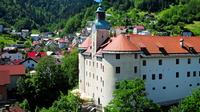Idrija Half Day Excursion: UNESCO Town including Castle and Mine Tour from Ljubljana
Ljubljana, Slovenia
Trip Type: Day Trips
Duration: 5 hours
A fascinating experience to discover the underground world of one of the oldest mercury mines in the world protected by UNESCO. Stroll through the halls of Idrija castle with collections focusing on mercury mining and lace making. Admire the beautiful, like a spider web shaped Idrija lace and presentation how is made; try it yourself!
More About This Activity All Day Trips →
A fascinating experience to discover the underground world of one of the oldest mercury mines in the world protected by UNESCO. Stroll through the halls of Idrija castle with collections focusing on mercury mining and lace making. Admire the beautiful, like a spider web shaped Idrija lace and presentation how is made; try it yourself!The town of Idrija, according to its inhabitants, is known mainly for two things - one of them being the mercury mine and the other the world-famous Idrija lace.
The history of mining in Idrija dates back to the 15th century when, according to a legend, a bucket maker working in a local spring spotted a small amount of liquid mercury. That happened in 1492, the year that Columbus set sail for the Americas. Only the Almadén mercury mine in Spain was bigger. Both towns were so famous that their names were used in North America for the mining towns of New Idria and New Almadén (both in California).
The mercury mine was the source of living for the miners. But as much as it provided living, it was also the scourge of early death by mercury poisoning.
Visitors decent into the mine with professional guides through Anthony's Shaft, dug back in 1500. They explore the underground world of the mine where they find hidden pockets of cinnabar ore and droplets of mercury, learn about the method of mining mercury, are introduced to life-size mannequins of workers over the ages and see the mid-18th century unique underground chapel Chapel of the Holy Trinity.
The old town is dominated by the Gewerkenegg Castle which in German means mine castle. It was built in the period from 1522-1533. On display in the castle is an exhibition of the five hundred-year history of the mercury mine's operation and an impressive retrospective exhibition of Idrija lace. The castle courtyard is beautifully decorated.
The craft of bobbin lace-making occupies a very important place in the history of Idrija for more than 300 years ago. Cloths and napkins, curtains and bed linen, clothes and ornaments for clothes, even earrings, necklaces and gloves are all products made of Idrija lace.
The history of mining in Idrija dates back to the 15th century when, according to a legend, a bucket maker working in a local spring spotted a small amount of liquid mercury. That happened in 1492, the year that Columbus set sail for the Americas. Only the Almadén mercury mine in Spain was bigger. Both towns were so famous that their names were used in North America for the mining towns of New Idria and New Almadén (both in California).
The mercury mine was the source of living for the miners. But as much as it provided living, it was also the scourge of early death by mercury poisoning.
Visitors decent into the mine with professional guides through Anthony's Shaft, dug back in 1500. They explore the underground world of the mine where they find hidden pockets of cinnabar ore and droplets of mercury, learn about the method of mining mercury, are introduced to life-size mannequins of workers over the ages and see the mid-18th century unique underground chapel Chapel of the Holy Trinity.
The old town is dominated by the Gewerkenegg Castle which in German means mine castle. It was built in the period from 1522-1533. On display in the castle is an exhibition of the five hundred-year history of the mercury mine's operation and an impressive retrospective exhibition of Idrija lace. The castle courtyard is beautifully decorated.
The craft of bobbin lace-making occupies a very important place in the history of Idrija for more than 300 years ago. Cloths and napkins, curtains and bed linen, clothes and ornaments for clothes, even earrings, necklaces and gloves are all products made of Idrija lace.
« Go Back

